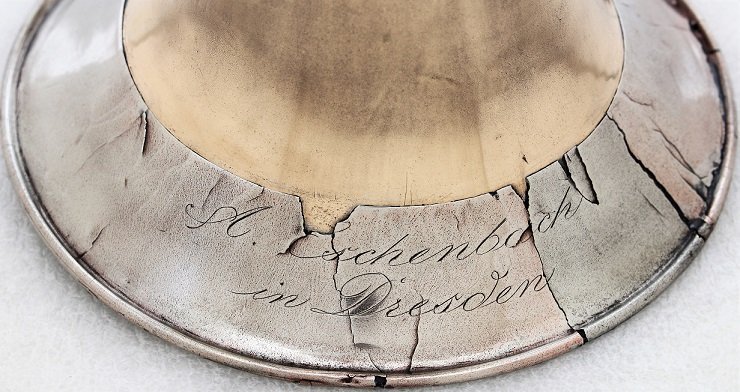Dresden Keyed Bugles
Dresden keyed bugles have been known about among brass history fans since Dr. Robert Eliason’s article, “The Dresden Keyed Bugle” was published in the Journal of the American Musical Instrument Society in 1977. This is a short article and I’m not familiar with any additional study done on the subject and I never had one in my hands to examine or in the shop for restoration until 2019, but then another, signed by (Carl August) “A. Eschenbach in Dresden” surfaced just two and a half years later. This one was acquired by Steve Ward and also wanted it restored. Much better known is a painting by American artist, William Harnett, that includes an image of a Dresden keyed bugle.
The unsigned example, made of copper with nickel silver trim, was purchased through an Internet auction by keyed brass collector and aficionado Hudson Graham. He contacted me, asking about restoration and information on the subject. I looked through my library and searched the Internet and then told him that if he does any more research, he will be the world’s expert on this keyed bugle variant.
The Eschenbach bugle is made of gold brass (higher copper content than yellow brass) with nickel silver trim. As you can see in the photos below, they are otherwise of very similar design. They also appear to be made to play in the same high pitch C, but both can easily be tuned to modern pitch.
Click on an image to see the gallery.
Dr. Eliason wrote: “This was an arrangement of six keys (seven in this case) divided equally between the left and right hands and dating from about 1820-1840. It was evidentially an attempt to divide the workload more evenly between the two hands and to create patterns of fingering alternating right and left hands. It was probably unsuccessful because, regardless of how logical the ideas might seem, it is demonstrably easier to manipulate the fingers of one hand accurately than to coordinate fingerings that alternate between two hands.”
Top view of keywork on unsigned Dresden bugle.
I had assumed that it would also be easier to hold in playing position because of the additional finger rings and the hands both supporting the larger mass of the instrument. Now that I’ve had one in my hands in playing condition, I have to report that it is quite as awkward to hold as any other keyed bugle, possibly worse. Some musicians must have overcome this obstacle and used these successfully. This examples shows wear on the key mechanism of many years of use.
Apparently, the name “Dresden Keyed Bugle” was assigned when Eliason learned of an example signed “I. G. Kersten, Dresden”, the only other known by him was one without signature in the Henry Ford Museum, where he worked at the time. We now know of examples signed: “R. Schober, Graslitz” and “Freidrich Schmidt, Leipzig”, but the name has seems to have stuck. The latter instrument was dated by Herbert Heide to about 1855. That maker was known to be active between 1845 and 1866. Also, two examples by Carl August Eschenbach, who was active in Dresden from 1851 until 1897. After receiving appointment as court instrument maker in 1865, his instruments included “Hof-Instrumentemacher” in the signature, indicating that Steve Ward’s bugle was made before that date.
It seems that the Dresden keyed bugle appeared in the 1850s, which was towards the end of the time that keyed bugles were commonly used in German countries. This likely accounts for the fact that surviving examples are so extremely rare today.
All of the known examples have the mouthpipe on the left side of the bell, whereas on the more common style of keyed bugle, it is on the right. The toneholes are in roughly the same positions as other keyed bugles, just different configuration of the keys. The overall length of the instrument is 15 3/4” and the bell diameter is 5 3/4”.
None of the known examples have original tuning shanks, so I was left guessing what this might have been. It is very possible that they had a fixed length mouthpipe shank and a set of tuning bits, as was seen on most common keyed bugles, such as that by Graves on this site. Neither needed enough length to allow for a “pigtail” crook, as most often seen on Bb keyed bugles. They are both in high pitch C with the mouthpipe shanks that I made, that can easily be lengthened to modern pitch.
Hudson reported to me that he is quickly learning the new fingerings on this bugle and enjoying playing it. He was likely the only Dresden keyed bugle player in well over 100 years, until it was taken up by Willi Budde in Germany. Mr. Budde owns another Eschenbach Dresden keyed bugle.
As you can see in the photos below, both of these keyed bugles were very deteriorated, the Eschenbach much worse than the copper bugle.








